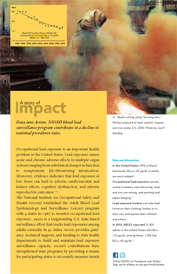Data into action. NIOSH blood lead surveillance program contributes to a decline in national prevalence rates.
July 2012
DHHS (NIOSH) Publication Number 2012-164

A Story of Impact:
Occupational lead exposure is an important health problem in the United States. Lead exposure causes acute and chronic adverse effects in multiple organ systems ranging from subclinical changes in function to symptomatic life-threatening intoxication. Moreover, evidence indicates that lead exposure at low doses can lead to adverse cardiovascular and kidney effects, cognitive dysfunction, and adverse reproductive outcomes.1-4
The National Institute for Occupational Safety and Health (NIOSH) established the Adult Blood Lead Epidemiology and Surveillance (ABLES) program with 4 states in 1987 to monitor occupational lead exposure. ABLES is a longstanding U.S. state-based surveillance effort that tracks lead exposures among adults currently in 41 states. NIOSH provides guidance, technical support, and funding to state health departments to build and maintain lead exposure surveillance capacity. NIOSH’s contributions have strengthened state programs by providing a means for participating states to accurately measure trends in adult lead exposures and effectively intervene to reduce lead exposure. NIOSH, the only federal funding source for adult lead exposure surveillance, provides a total of $812,500 to 40 state ABLES programs each year. One additional state participates but receives no ABLES funding. In 2010, using a new elevated blood lead level (BLL) case definition, the ABLES program reported a rate of 26.4 adults with BLLs greater than or equal to 10 micrograms per deciliter (≥10 μg/dL) per 100,000 employed.5 These data indicate that lead remains a national occupational health problem, and that continued efforts to reduce lead exposures are needed.
Relevant Information
- In the United States, 95% of blood lead levels (BLLs) ≥25 μg/dL in adults are work related.6
- Occupational lead exposure occurs mainly in battery manufacturing, lead and zinc ore mining, and painting and paper hanging.6
- Lead-exposed workers can take lead home on their clothing, bodies or in their cars and expose their children and others.7
- In 2010, ABLES reported 31,459 adults in the United States with BLLs ≥10 μg/dL; among these, 1,388 had BLLs ≥40 μg/dL.5
Impact
Visit www.cdc.gov/niosh/topics/ABLES/ables.html for more information about research efforts to protect the safety and health of adults exposed to lead.
To receive NIOSH documents or more information about occupational safety and health topics, please contact NIOSH.
Telephone: 1-800-cdc-info (1-800-232-4636) | TTY: 1-888-232-6348 | email: cdcinfo@cdc.gov | www.cdc.gov/niosh
For a monthly update on news at NIOSH, subscribe to NIOSH eNews by visiting www.cdc.gov/niosh/eNews.
DHHS (NIOSH) Publication No. 2012-164
References
1- Association of Occupational and Environmental Clinics [2007]. Medical management guidelines for lead-exposed adults. Washington, DC.: Association of Occupational and Environmental Clinics. http://www.aoec.org/documents/positions/mmg_final.pdf
2- Kosnett MJ, Wedeen, RP, Rothenberg SJ, et al. [2007]. Recommendations for medical management of adult lead exposure. Environ Health Perspect 2007;115:463—71. http://www.ehponline.org/members/2006/9784/9784.pdf
3- CDC (Centers for Disease Control and Prevention) [2010]. Guidelines for the Identification and Management of Lead Exposure in Pregnant and Lactating Women. Atlanta, GA.: Centers for Disease Control and Prevention. https://www.cdc.gov/nceh/lead/publications/LeadandPregnancy2010.pdf
4- National Toxicology Program [2012]. Health Effects of Low-level Lead Evaluation. http://ntp.niehs.nih.gov/go/36443
5- CDC (Centers for Disease Control and Prevention [2011]. NIOSH. Adult Blood Lead Epidemiology & Surveillance (ABLES) program. https://www.cdc.gov/niosh/topics/ABLES/ables.html
6- CDC (Centers for Disease Control and Prevention [2010]. Adult Blood Lead Epidemiology and Surveillance – United States, 2008 – 2009 Morbidity and Mortality Weekly Report. 2011;60(25):841-5. https://www.cdc.gov/mmwr/preview/mmwrhtml/mm6025a2.htm
7- CDC (Centers for Disease Control and Prevention) [2008]. Childhood Lead Poisoning Associated with Lead Dust Contamination of Family Vehicles and Child Safety Seats — Maine, 2008. Morbidity and Mortality Weekly Report. 2008;58(32):890-3. https://www.cdc.gov/mmwr/preview/mmwrhtml/mm5832a2.htm
8- OSHA (Occupational Safety and Health Administration) [2008]. Directive number: CPL 03-00-009. OSHA Instruction; National Emphasis Program-Lead. : Washington, DC.: Occupational Safety and Health Administration http://www.osha.gov/pls/oshaweb/owadisp.show_document?p_table=DIRECTIVES&p_id=4031 and http://www.osha.gov/OshDoc/Directive_pdf/CPL_03-00-0009.pdf
9- CSTE (Council of State and Territorial Epidemiologists) [2009]. Position Statement. Public Health Reporting and National Notification for Elevated Blood Lead Levels 2009. . Atlanta, GA.: Council of State and Territorial Epidemiologists. http://www.cste.org/ps2009/09-OH-02.pdf
10- CDC (Centers for Disease Control and Prevention) [2010]. Nationally Notifiable Non-Infectious Conditions. United States 2010. Elevated Blood Lead Levels. 2010. Atlanta, GA.: Centers for Disease Control and Prevention. https://www.cdc.gov/osels/ph_surveillance/nndss/phs/non_infdis2010.htm
https://www.cdc.gov/osels/ph_surveillance/nndss/casedef/lead_current.htm
11. U.S. Department of Health and Human Services [2010]. Healthy people 2020. Occupational Safety and Health Objective 7. Reduce the proportion of persons who have elevated blood lead concentrations from work exposures. : Washington, DC.: U.S. Department of Health and Human Services
http://www.healthypeople.gov/2020/topicsobjectives2020/objectiveslist.aspx?topicid=30
http://www.healthindicators.gov/Indicators/Elevated-blood-lead-rates-in-adults_1300/National_0/Profile
